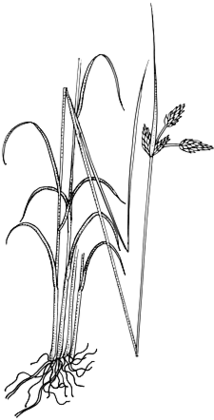
Description: Perennials with long-creeping rhizomes with subglobose woody tubers. Culms triquetrous to trigonous, usually several-noded, leafy, solitary from tuber.
Leaves numerous, well-developed, leathery, with margins and midribs scabrous towards the apex; ligule absent; lower sheaths often septate-nodulose.
Inflorescence umbel-like, with a basal cluster of sessile spikelets plus several smooth branches, or sometimes head-like; lower involucral bracts leafy, several longer than inflorescence. Spikelets ovoid to cylindrical, with numerous bisexual flowers. Glumes spirally arranged, pubescent, with laciniate apex and long excurved mucro. Hypogynous bristles 6, retrorsely scabrous, sometimes deciduous. Stamens 3. Style 2- or 3-fid, not dilated at base, deciduous.
Nut trigonous or biconvex, obovoid.
Distribution and occurrence: World: c. 16 species, cosmopolitan. Australia: 4 or 5 species (?native), all States.
Species in this genus are very similar vegetatively, and the main distinguishing feature is the nut. The genus needs revision worldwide. **B. robustus (Pursh) Soják – An immature specimen from Lake Illawarra may belong to this North American species.
Text by K. L. Wilson
Taxon concept:
| | Key to the species | |
| 1 | Nut equally trigonous, with the dorsal angle acute, pale yellow or grey and dull to blackish and shining; style 3-fid | Bolboschoenus fluviatilis |
| Nut lenticular or unequally trigonous with the dorsal angle obtuse, surface variously coloured, always shining; style 2- or 3-fid | 2 |
| 2 | Nut lenticular; nut straw-coloured to dark golden brown, the surface minutely but obviously reticulate; style 2-fid | Bolboschoenus caldwellii |
| Nut plano-convex or trigonous, darker in colour, the surface not obviously reticulate; style 2- or 3-fid
Back to 1 | 3 |
| 3 | Nut dark red-brown to black | Bolboschoenus medianus |
| Nut olive-brown to very dark yellow-brown
Back to 2 | Bolboschoenus robustus |
|


